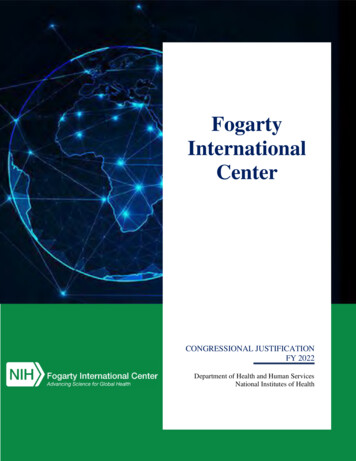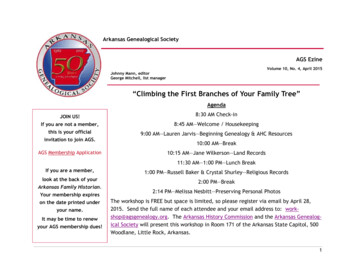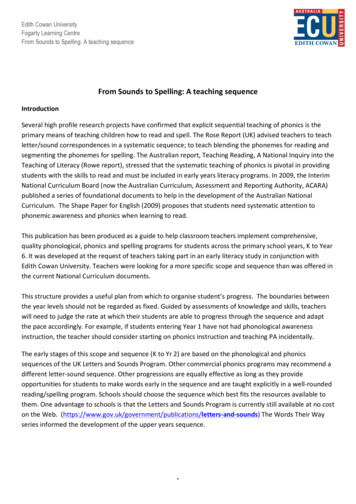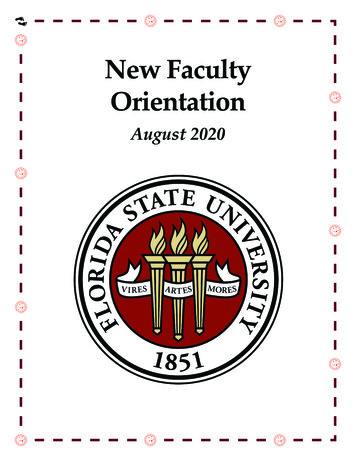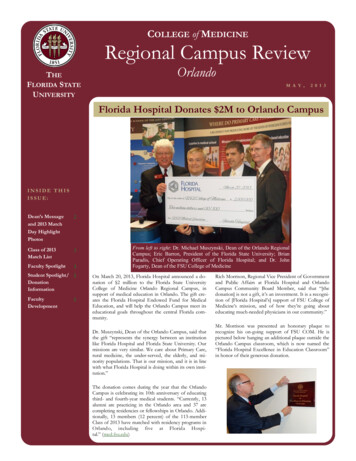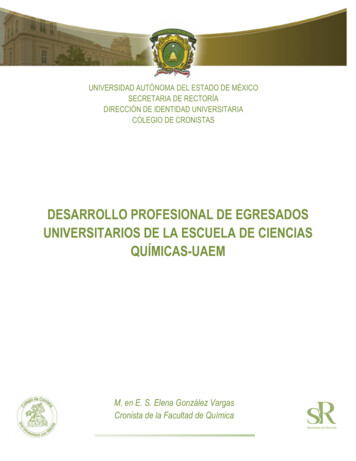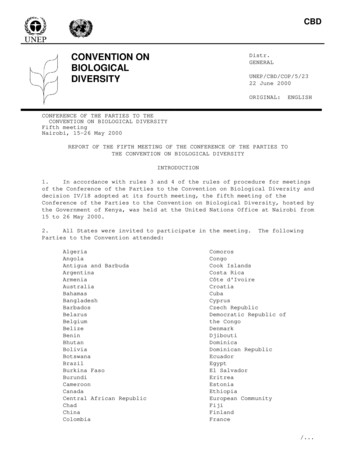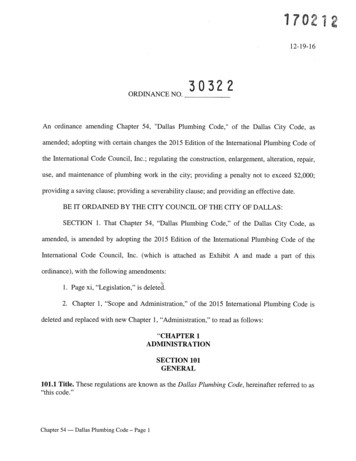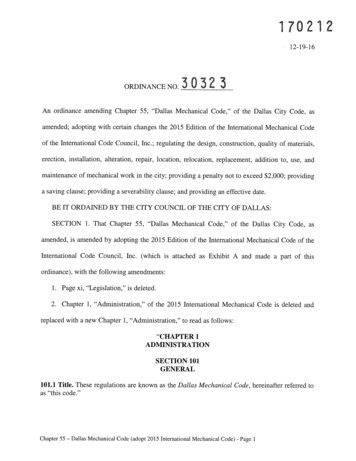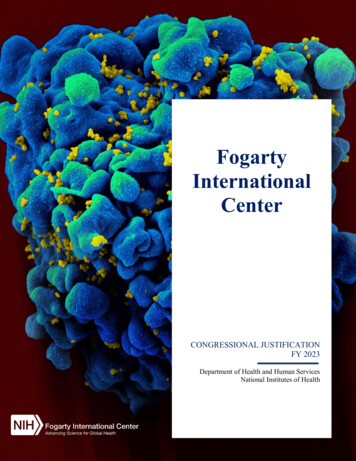
Transcription
FogartyInternationalCenterCONGRESSIONAL JUSTIFICATIONFY 2023Department of Health and Human ServicesNational Institutes of Health
[THIS PAGE INTENTIONALLY LEFT BLANK]
DEPARTMENT OF HEALTH AND HUMAN SERVICESNATIONAL INSTITUTES OF HEALTHFogarty International Center (FIC)FY 2023 Budget Table of ContentsPage No.Director’s Overview. 3IC Fact Sheet . 9Major Changes in the Fiscal Year 2023 Budget Request . 11Budget Mechanism Table . 12Appropriations Language. 13Summary of Changes . 14Fiscal Year 2023 Budget Graphs . 15Organization Chart . 16Budget Authority by Activity . 17Justification of Budget Request . 18Appropriations History . 23Authorizing Legislation . 24Amounts Available for Obligation. 25Budget Authority by Object Class . 26Salaries and Expenses . 27Detail of Full-Time Equivalent (FTE) . 28Detail of Positions . 29FIC-1
[THIS PAGE INTENTIONALLY LEFT BLANK]FIC-2
Director’s OverviewThe mission of the Fogarty International Center is to advance themission of the National Institutes of Health (NIH) by supportingand facilitating global health research conducted by U.S. andinternational investigators, building partnerships between healthresearch institutions in the U.S. and abroad, and training the nextgeneration of scientists to address global health needs.Programmatically, Fogarty complements and supports work ofother NIH Institutes, Centers, and Offices by identifying scientificopportunities and catalyzing science on global issues of relevanceto Americans. With a focus on countries with less developedresearch capacity, we support early-career scientists who often goon to receive support from other NIH institutes. Fogarty alsoserves as a focal point for global health and international activitiesacross NIH, representing the NIH international research agendawithin the U.S. Government, with foreign governments, and withkey international research organizations.Roger I. Glass, M.D., Ph.D.Director of FIC andAssociate Director forInternational ResearchDiseases know no borders while the health of Americans is increasingly intertwined with that ofpopulations around the world, as clearly demonstrated by the COVID-19 pandemic. Ourprograms strengthen the scientific workforce and develop global research networks that areprepared to combat existing and future threats that affect us all, including pandemic response,climate impacts on health, health disparities, and a wide range of diseases and conditions.In addition, Fogarty investments benefit the United States by extending the reach andcompetitiveness of U.S. universities. Currently, Fogarty supports 385 research and researchtraining awards involving 124 U.S. universities. Nearly all of these awards involve U.S.researchers and two-thirds of Fogarty grants are awarded to U.S. institutions which partner withresearch institutions in low- and middle-income countries (LMICs), These collaborations resultin long-term relationships that provide scientific and training opportunities for both partners andhelp American scientists remain globally competitive and stay at the forefront of scientificdiscovery.NIH in a Changing World: Science to Enhance Human HealthSince its establishment more than 50 years ago, Fogarty has laid the groundwork to respond tothe changing world by making foundational investments in the scientific workforce, developingglobal research networks that can quickly respond, harnessing new tools and researchapproaches, and devoting attention to emerging global challenges such as pandemics, climatechange, and social injustice and serve as the focal point for international affairs at NIH.Developing the Scientific WorkforceCentral to Fogarty’s mission is our focus on preparing the next generation of scientists torespond to current and future threats to health by providing opportunities to tie biomedicalresearch to real world applications. For example, Fogarty’s HIV Research Training programFIC-3
and its predecessor programs have developed generations of global health leaders who havecontributed to breakthroughs in the prevention, treatment, and care of people living with HIV.For example, Dr. Lloyd Mulenga received his Ph.D. with Fogarty support and is now a leadinginfectious disease researcher at the University of Zambia. He designed a clinical trialdemonstrating the effectiveness and safety of a drug that has become the World HealthOrganization’s (WHO) preferred treatment option for many people living with HIV. Fogarty’ssupport for HIV research training has helped build human capacity and develop institutionalcapabilities that are now being applied to address other diseases.Fogarty supports cross-cutting research and research training programs that apply to a broadrange of health threats, enabling grantees and trainees to anticipate new challenges. Fogartyprograms also support training for researchers in the development and use of powerful tools suchas data science, mobile health, and bioinformatics, which can be applied to a wide range andvariety of health challenges. More than 7,500 individuals from 132 countries trained throughFogarty programs since 1989.Fostering Collaborative Global NetworksAcross our scientific portfolio, Fogarty supports networks of U.S. and international scientistswho collaborate across borders and can rapidly respond to new and emerging health threats. Forexample, Fogarty supports the African Forum for Research and Education in Health(AFREhealth), a leadership and convening organization that brings academic health researchprofessionals – including doctors, nurses, pharmacists, lab scientists, and allied healthprofessionals – together to develop and share best practices, innovations, curricula, and policy.The powerful network was designed to address health workforce issues and the HIV/AIDS crisis.However, when the COVID-19 pandemic hit, the network rapidly pivoted to help identify andshare best practices for dealing with the pandemic across Africa.Harnessing Promising Research ApproachesFogarty leverages several cutting-edge research approaches to respond to our changing world.For example, Fogarty’s in-house epidemiology team uses advanced computational modelingand genomic analysis tools to better predict and respond to emerging infectious diseaseoutbreaks. Through support from the NIH Common Fund and in partnership with 10 NIHInstitutes, Centers, and Offices, Fogarty helped launch the new Harnessing Data Science forHealth Discovery and Innovation in Africa (DS-I Africa) program. DS-I Africa supports anAfrican-led consortium that will employ innovative approaches such as big data analysis,artificial intelligence, and computational modeling to transform health in Africa over the nextfive years.Fogarty’s Mobile Health: Technology and Outcomes in LMICs (mHealth) programimplements an innovative two-phase funding approach that emphasizes rigorous evaluations atthe proof-of-concept stages followed by opportunities for scaling up only the interventions thatare proven effective.Dissemination and implementation research is woven throughout Fogarty programs as animportant strategy for translating evidence into policy and practice. For example, Fogarty leadsthe Clean Cooking Implementation Science Network (ISN) in partnership with the NIHFIC-4
Common Fund, U.S. Agency for International Development (USAID), Centers for DiseaseControl and Prevention (CDC), Environmental Protection Agency (EPA), and the GlobalAlliance for Clean Cookstoves (GACC). Household air pollution from cooking on open fires ortraditional stoves results in premature death in many LMICs, including places where cleanercooking alternatives are available. The ISN supports collaboration between researchers andimplementation organizations to study how to improve uptake of evidence-based clean cookinginterventions in these settings.Responding to the COVID-19 PandemicFogarty’s investments in the scientific workforce and collaborative networks enabled researchersaround the world to quickly respond to the pandemic. Past and current grantees and traineesplayed major roles in the research response to the COVID-19 pandemic in their countries whilealso providing expert analysis to policymakers. In her native South Africa, former Fogartyfellow Dr. Glenda Gray co-led the Johnson & Johnson COVID-19 vaccine clinical trial, whichdemonstrated high efficacy and supported global use of the vaccine. Fogarty grantee Dr.Christian Happi of Nigeria was the first to sequence the full COVID-19 viral genome in Africaand continues to lead the scientific response to the pandemic in his country. Members of theFogarty network are also leading pandemic responses in China, Haiti, Peru, South Africa, andother locations.Recently, Fogarty further supported this powerful research network by awarding 3.3 million inadministrative supplements to support research on unique scientific questions and researchtraining activities related to COVID-19. These projects covered critical issues such as mentalhealth, interactions between COVID-19 and other infectious diseases (e.g., HIV andtuberculosis), vaccine hesitancy, intimate partner violence, stigma related to mental health, andother topics.Fogarty’s Division of International Research (DIR) played an important role in the response aswell, helping coordinate COVID-19 response activities across NIH and the U.S. Government,with multilateral organizations, and in partnership with several specific countries.Preparing for Future PandemicsFogarty’s foundational investments in the scientific workforce and global networks promise to beeffective against future pandemics. Dr. Andrew Kambugu received advanced training ininfectious disease research in the United States with Fogarty support and then returned toUganda, ultimately rising to the position of Executive Director of the Infectious Disease Institute(IDI). Under his leadership, IDI established a global health security program in 2016, enablingthe institute to contribute to the COVID-19 response and prepare for future threats.Fogarty’s Division of International Epidemiology and Population Studies (DIEPS) furthersupports pandemic preparedness through its ongoing research and research training onepidemiological modeling and genomic epidemiology. Fogarty will continue to accelerateresearch capacity strengthening in LMICs in several areas of importance to pandemicpreparedness, such as mathematical modeling, medical countermeasure research, genomicsurveillance of emerging infectious diseases, and other areas of research such as epidemiology,mental health, and social factors.FIC-5
Responding to Climate ChangeOver the past decade, several Fogarty programs have explored the impacts of environmental andclimate change on human health, especially on underserved populations. The GlobalEnvironmental and Occupational Health (GEOHealth) program supports interdisciplinaryresearch and research training hubs composed of clinicians, public health professionals, medicalstudents, and undergraduates from across academia, government, and non-governmentalorganizations (NGOs). The network has contributed to scientific advancements and informedpolicies related to outdoor air pollution, household air pollution, heat stress, agricultural health,environmental contamination, and industrialization. The GEOHealth Hubs recently led gapanalyses on the impacts of climate change on human health in Ethiopia, Kenya, Rwanda, andUganda, outlining recommendations for improved coordination across sectors, policy guidelines,and considerations for gender and community-related perspectives.Global climate change is expected to fuel more frequent and intense heat waves in many parts ofthe world, including the United States as seen in the deadly 2021 heat wave in the Northwest.Following a lethal heat wave in India several years ago, an international research team supportedby Fogarty and the National Institute of Environmental Health Sciences (NIEHS) worked withlocal officials in India to consider how to better prepare for future heat waves. Researchactivities such as this offer opportunities for shared learning in dealing with intense changes inclimate worldwide.Looking to the future, Fogarty is partnering with NIEHS to lead the planning of a new, NIHwide effort to identify, understand, and address the health impacts of climate change, withspecial attention to the underserved communities in the United States and abroad that are oftendisproportionately impacted.Towards Social Justice and Health EquityFogarty stands with NIH in condemning racism and bigotry in all its forms and remainscommitted to contributing to health equity for all the world’s people. The COVID-19 pandemiclaid bare the inequities in our health systems – both at home and abroad. Meanwhile, the harshhealth impacts of climate change and the pandemic are disproportionately felt by the underservedpopulations around the world.Health equity is at the heart of our mission as we focus our scientific activities on disadvantagedpopulations in low-resource settings globally. Across our grant programs and scientificactivities, we strive to foster equitable research partnerships, ensure that participatingcommunities benefit from knowledge gained, and empower local scientists to lead research andpublications. For example, Fogarty’s Reducing Stigma to Improve HIV/AIDS Prevention,Treatment and Care in LMICs program includes grants focused on particularly marginalizedor vulnerable communities. As stigma is a global phenomenon, Fogarty recently highlightedseveral case examples of interventions developed abroad that have been successfully transferredfrom LMICs to the United States, thus offering valuable lessons to the stigma researchcommunity in the United States.FIC-6
Fogarty is also committed to improving diversity among our staff and the global health researchworkforce. Diverse perspectives are essential to advancing science, especially in the globalhealth arena where there are many differences in regional, gender, and cultural experiences.Addressing health disparities is integral to Fogarty’s approach to the scientific workforce. Forexample, the Health-Professional Education Partnership Initiative (HEPI) is led by Africaninstitutions working to strengthen the local health and research workforce, informed by the needsof local communities. Developing a workforce that serves both urban and rural areas helpsaddress health disparities that arise within these communities.Fogarty will continue to work towards greater equity in global health research, in our owninvestments and in partnership with other Institutes and Centers at NIH. With input from ourgrantees, trainees, and partners, we are currently developing strategies to achieve this goal. Thiscommitment will complement investments in research and research training that confrontdisparities in health in low-resource settings globally. It is essential to achieving Fogarty’svision – a world in which the frontiers of health research extend across the globe and advances inscience are implemented to reduce the burden of disease, promote health, and extend longevityfor all people.FIC-7
[THIS PAGE INTENTIONALLY LEFT BLANK]FIC-8
IC Fact SheetFIC-9
FIC-10
Major Changes in the Fiscal Year 2023 Budget RequestMajor changes by budget mechanism and/or budget activity detail are briefly described below.Note that there may be overlap between budget mechanism and activity detail, and thesehighlights will not sum to the total change for the FY 2023 President’s Budget request for FIC,which is 95.8 million, an increase of 11.8 million from the FY 2022 Continuing Resolution(CR) level. FIC will pursue research priorities through strategic investments and carefulstewardship of appropriated funds. 10.0 million of the increase will be directed to HealthDisparities Research, which will fund research in multiple mechanisms and activities.Research Project Grants (RPGs) ( 3.0 million, total 15.8 million):FIC will support a total of 69 Research Project Grant (RPG) awards in FY 2023, an increase of14 awards and 3.0 million, or 23.4 percent, from the FY 2022 CR level. A portion of thisincrease will be for Health Disparities Research.Research Centers and Other Research ( 7.0 million, total 52.4 million):Research Center awards will increase by 0.2 million, or 15.4 percent, relative to the FY 2022CR level; Career awards will increase by 1.3 million, or 15.4 percent; and Other-Other awardswill increase by 5.6 million, or 15.4 percent. Most of the increases will be for HealthDisparities Research.Research Management and Support ( 1.3 million, total 21.6 million):Research Management and Support (RMS) will increase 1.3 million, or 6.4 percent, relative tothe FY 2022 CR level. This will cover pay cost increases and other inflation, an increase incyber-security costs, and additional support needed to manage the expanded Health DisparitiesResearch portfolio.FIC-11
Budget Mechanism TableNATIONAL INSTITUTES OF HEALTHFogarty International CenterBudget Mechanism - Total¹(Dollars in Thousands)MECHANISMFY 2021 FinalNo.Research Projects:NoncompetingAdministrative , CompetingSubtotal, RPGsSBIR/STTRResearch Project GrantsFY 2022 CRAmountNo.FY 2023 /FY 2022 CRFY 2023 President's BudgetAmountNo.AmountNo.Amount41(10) 7,7841,06223(10) 5,6891,00035(10) 8,3291,00012(0) 2,6400022022630634373,9650 4,401 13,2480 13,248032032550554375,7000 6,137 12,8250 12,825034034690694376,0560 6,493 15,8220 15,82202021401403560 356 2,9960 2,996000000 1,0690000 1,069000000 1,0380000 1,038000000 1,1990000 1,199000000 1600000 160800000157237300 8,603000037,058 45,661 59,978780000152230285 8,356000035,993 44,349 58,213900000175265334 9,646000041,547 51,193 68,213120000233549 1,29000005,555 6,844 10,001000 00 0000 00 0000 00 0000 00 0Research & Develop. Contracts(SBIR/STTR) (non-add)0(0) 4,563(0)0(0) 5,537(0)0(0) 6,000(0)0(0) 462(0)Intramural ResearchRes. Management & SupportSBIR Admin. ,588(0)00(0)01,294(0)5800 83,7616100 84,0446100 95,801000 11,757Research Centers:Specialized/ComprehensiveClinical ResearchBiotechnologyComparative MedicineResearch Centers in Minority InstitutionsResearch CentersOther Research:Research CareersCancer EducationCooperative Clinical ResearchBiomedical Research SupportMinority Biomedical Research SupportOtherOther ResearchTotal Research GrantsRuth L Kirschstein Training Awards:Individual AwardsInstitutional AwardsTotal Research TrainingConstructionBuildings and FacilitiesTotal, FICFTTPsFTTPsFTTPs¹ All items in italics and brackets are non-add entries.FIC-12FTTPs
Appropriations LanguageNATIONAL INSTITUTES OF HEALTHJOHN E. FOGARTY INTERNATIONAL CENTERFor carrying out the activities of the John E. Fogarty International Center (described in subpart2 of part E of title IV of the PHS Act), 95,801,000.FIC-13
Summary of ChangesNATIONAL INSTITUTES OF HEALTHFogarty International CenterSummary of Changes(Dollars in Thousands) 84,044 95,801 11,757FY 2022 CRFY 2023 President's BudgetNet changeFY 2022 CRCHANGESFTEsA. Built-in:1. Intramural Research:a. Annualization of January 2022 pay increase & benefitsb. January FY 2023 pay increase & benefitsc. Paid days adjustmentd. Differences attributable to change in FTEe. Payment for centrally furnished servicesf. Cost of laboratory supplies, materials, other expenses, and non-recurring costsSubtotalFY 2023 President's BudgetBudgetAuthority2. Research Management and Support:a. Annualization of January 2022 pay increase & benefitsb. January FY 2023 pay increase & benefitsc. Paid days adjustmentd. Differences attributable to change in FTEe. Payment for centrally furnished servicesf. Cost of laboratory supplies, materials, other expenses, and non-recurring costsSubtotalFTEsBuilt-In Change from FY 2022 CRBudgetAuthorityFTEsBudget Authority 000000 000000 000000 0 9,9989,9989,9989,998010,296 10,36310,36310,36310,363011,225 66337-3800223 588Subtotal, Built-in 588FY 2022 CRCHANGESFY 2023 President's BudgetProgram Change from FY 2022 CRNo.AmountNo.AmountNo.Amount2332055 6,6896,1370 12,8253534069 9,3296,4930 15,822122014 2,6403560 2,9960 1,0380 1,1990 16023044,34926551,193356,8444. Research Training0000005. Research and development contractsSubtotal, Extramural05,537 63,75006,000 74,2130462 10,463B. Program:1. Research Project Grants:a. Noncompetingb. Competingc. SBIR/STTRSubtotal, RPGs2. Research Centers3. Other Research6. Intramural ResearchFTEs0 0FTEs0 0FTEs0 06120,2946121,58807067. Research Management and Support8. Construction09. Buildings and FacilitiesSubtotal, Program61Total built-in and program changes0 84,0440610 95,801000 11,169 11,757FIC-14
Fiscal Year 2023 Budget GraphsHistory of Budget Authority and FTEs:Distribution by Mechanism:Change by Selected Mechanisms:FIC-15
Organization ChartFIC-16
Budget Authority by ActivityNATIONAL INSTITUTES OF HEALTHFogarty International CenterBudget Authority by Activity¹(Dollars in Thousands)FY 2021 FinalExtramural ResearchFTEFY 2022 CRFY 2023 President'sBudgetFY 2023 /FY 2022 CRAmount FTEAmount FTEAmount FTEAmount 20,01629,65714,868 64,541 0 19,220 83,761 19,77129,29314,686 63,750 0 20,294 84,044 23,01634,10117,096 74,213 0 21,588 95,801 3,2454,8082,410 10,463 0 1,294 11,757DetailResearch Capacity StrengtheningDevelopment of Human Resources for Global HealthInternational Collaborative ResearchSubtotal, ExtramuralIntramural ResearchResearch Management & SupportTOTAL05858¹ Includes FTEs whose payroll obligations are supported by the NIH Common Fund.FIC-170616106161000
Justification of Budget RequestFogarty International CenterAuthorizing Legislation: Section 301 and Title IV of the Public Health Service Act, as amended.Budget Authority (BA):BAFTEFY 2021Final 83,761,00058FY 2022ContinuingResolution 84,044,00061FY 2023President'sBudget 95,801,00061FY 2023 /FY 2022 11,757,0000Program funds are allocated as follows: Competitive Grants/Cooperative Agreements;Contracts; Direct Federal/Intramural and Other.Overall Budget Policy: The FY 2023 President’s Budget request is 95.8 million, an increase of 11.8 million or 14.0 percent compared with the FY 2022 Continuing Resolution level. Thisincludes an increase of 10.0 million to expand Fogarty research into issues of health disparities.FIC-18
Global Trauma and Injury Research TrainingProgramProgram DescriptionsResearch Capacity Strengthening: Thedevelopment of effective measures to addressshared health challenges requires U.S. andLMIC institutions that can conduct robustresearch and train the next generation ofscientists to solve complex problems. Theseinstitutions can stimulate innovative andmultidisciplinary research, generate effectiveand implementable solutions, and build animble and networked research workforce.Given that important scientific findings cancome from anywhere in the world, Fogarty’sresearch capacity strengthening approachprovides LMIC institutions and researcherswith the tools to develop strong, sustainableresearch environments that contribute to theadvancement of global health. This programarea includes extramural research programsaddressing a broad range of health and diseaseareas, including bioethics, infectious diseases,information and communication technology,trauma and injury, and epidemics such asEbola and HIV/AIDS.Budget Policy:The FY 2023 President’s Budget request is 23.0 million, an increase of 3.2 million, or16.4 percent, from the FY 2022 CR level.Injuries and trauma are among the leading causes ofdeath and disability around the world, accounting forabout 10 percent of all deaths globally – more thanthe combined deaths due to HIV/AIDS, tuberculosis,malaria, and Ebola. This includes injuries and traumacaused by traffic accidents, drownings, poisonings,falls, burns, natural disasters, war, self-inflictedviolence, and assault.The Fogarty Global Trauma and Injury ResearchTraining Program aims to strengthen injury andtrauma research capacity at academic institutions inLMICs. The program supports in-depth training inresearch design, methods, and analytic techniques tohelp scientists study how to develop interventions toprevent and treat trauma and injury based on localculture and circumstances.For example, a grant to the University of Maryland hasbeen building research capacity in trauma and injurythroughout the Middle East and North Africa, providingintensive summer courses and mentored researchprojects over the past 15 years. More than 450trainees have participated from Egypt, Iraq, Sudan,Libya, the West Bank, and Afghanistan, with manygoing on to leadership positions in national healthministries or health care systems.One such trainee, Dena Abozaid, is a physician onfaculty at Ain Sharms University in Egypt. Theprogram strengthened her skills in epidemiology,research methodology, and ethics. Upon returning toEgypt, she applied her learning to study workplaceviolence against physicians and nurses at the hospitallevel. She implemented and evaluated a trainingadapted from Occupational Safety and HealthAdministration (OSHA) guidelines to help nursesidentify and manage potentially violent situations inthe healthcare sector.Photo by Daniel Snyder for FIC/NIHFIC-19
Ecology and Evolution of InfectiousDiseasesHuman interaction with animals and the environmenthas a significant impact on the emergence andspread of infectious diseases. For example,deforestation, expansion of human settlements,global trade and travel, and livestock production caninfluence spillover events, which occur whendiseases jump from animals to humans.Fogarty’s Ecology and Evolution of InfectiousDiseases (EEID) Program is a partnership with theNational Science Foundation to help understand therelationships between human-induced environmentalchanges and infectious diseases. The programfunds highly interdisciplinary research projects thatapply both ecological and biomedical methods, andstudy how environmental events such as climatechange, habitat alteration, biological invasion, andpollution alter the risks of emergence andtransmission of viral, parasitic, and bacterialdiseases in humans and other animals.Under an EEID grant, a research team led by Dr.Jason Rohr at the University of Notre Dame hasbeen studying schistosomiasis, a debilitating diseasethat affects nearly 240 million people worldwide. Theteam partnered with a Senegalese biomedicalresearch institute to study the environmentalinteractions of snails that hosts a parasite thatcauses schistosomiasis, which was affecting nearly80 percent of rural children in the area. Theydiscovered that construction of a dam and the use ofagricultural chemicals and insecticides played a rolein the spread of the parasite. Through a carefullyplanned intervention, the team was able to greatlyreduce the scourge of schistosomiasis on the localcommunity. On a broader scale, the researchershave used epidemiological modeling andcomputational simulations to show how sensitive thehost and parasite organisms are to temperaturechange, suggesting that global climate change willincrease health risks from schistosomiasis in someparts of the world.International Collaborative Research: Fogartysupported research collaborations between U.S.and LMIC scientists make U.S. academicinstitutions more globally competitive andenable U.S. scientists to lead and participate ininternational research teams that address keyglobal health priorities. These partnerships leadto more robust solutions to global healthproblems, as the respective strengths andexpertise of local and U.S. scientists are broughtto bear on complex challenges. Whether thefocus is international collaborative research ondisorders and diseases of the brain and nervoussystem, or the prediction and containment ofemerging infectious diseases, discoveries andevidence generated by these projects haveimplications for U.S. populations. This programarea includes extramural research programsaddressing a broad range of health topics,including brain disorders, ecology of infectiousdiseases, non-communicable diseases (NCDs),environmental and occupational health, mobilehealth, and HIV/AIDS-related stigma.Budget Policy:The FY 2023 President’s Budget request is 17.1million, an increase
Director's Overview . The mission of the Fogarty International Center is to advance the mission of the National Institutes of Health (NIH) by supporting and facilitating global health research conducted by U.S. and international investigators, building partnerships between health
